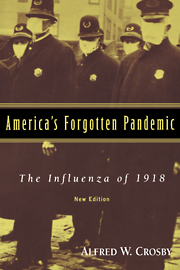Book contents
- Frontmatter
- Contents
- List of Graphs and Tables
- Preface to the New Edition
- PART I An Abrupt Introduction to Spanish Influenza
- PART II Spanish Influenza: The First Wave—Spring and Summer, 1918
- PART III The Second and Third Waves
- 4 The United States Begins to Take Note
- 5 Spanish Influenza Sweeps the Country
- 6 Flu in Philadelphia
- 7 Flu in San Francisco
- 8 Flu at Sea on the Voyage to France
- 9 Flu and the American Expeditionary Force
- 10 Flu and the Paris Peace Conference
- PART IV Measurements, Research, Conclusions, and Confusions
- PART V Afterword
- Index
5 - Spanish Influenza Sweeps the Country
Published online by Cambridge University Press: 05 June 2012
- Frontmatter
- Contents
- List of Graphs and Tables
- Preface to the New Edition
- PART I An Abrupt Introduction to Spanish Influenza
- PART II Spanish Influenza: The First Wave—Spring and Summer, 1918
- PART III The Second and Third Waves
- 4 The United States Begins to Take Note
- 5 Spanish Influenza Sweeps the Country
- 6 Flu in Philadelphia
- 7 Flu in San Francisco
- 8 Flu at Sea on the Voyage to France
- 9 Flu and the American Expeditionary Force
- 10 Flu and the Paris Peace Conference
- PART IV Measurements, Research, Conclusions, and Confusions
- PART V Afterword
- Index
Summary
The pandemic in the United States is succinctly described in three sets of figures: the numbers of flu and pneumonia deaths, week by week, of the three great categories of Americans in 1918: sailors, soldiers, and civilians. It might be better to use the statistics on cases, rather than deaths, as our measure, but influenza wasn't made a reportable disease for civilians in most parts of the nation until after the pandemic was in full flame, and even after that the case statistics were collected and sent to the Census Bureau from areas where only 77.8 percent of the estimated civilian population lived. The best weekly mortality statistics we have are for 45 of the nation's largest cities. The rises and declines of these latter statistics probably preceded those of the entire population by several days and more, because the pandemic penetrated and then departed from the rural areas later than the cities: but these numbers are good enough for our purpose, if their limitations are kept in mind.
The pandemic struck the two armed services earlier and more severely than the civilian population: and, to a considerable extent, the armed services were the foci from which the civilian population received the disease. The belief that the nation's protectors were now the source of its greatest immediate danger was common enough for some civilians to regard the military with fear. J. W. Inches, Commissioner of Health of Detroit, Michigan, sent off telegrams to the commanders of all army and navy camps in the Middle West informing them that Detroit, as of Ocober 19, would be off limits to all military personnel except those in perfect health on necessary military business and carrying a letter from a superior officer to that effect.
- Type
- Chapter
- Information
- America's Forgotten PandemicThe Influenza of 1918, pp. 56 - 69Publisher: Cambridge University PressPrint publication year: 2003



